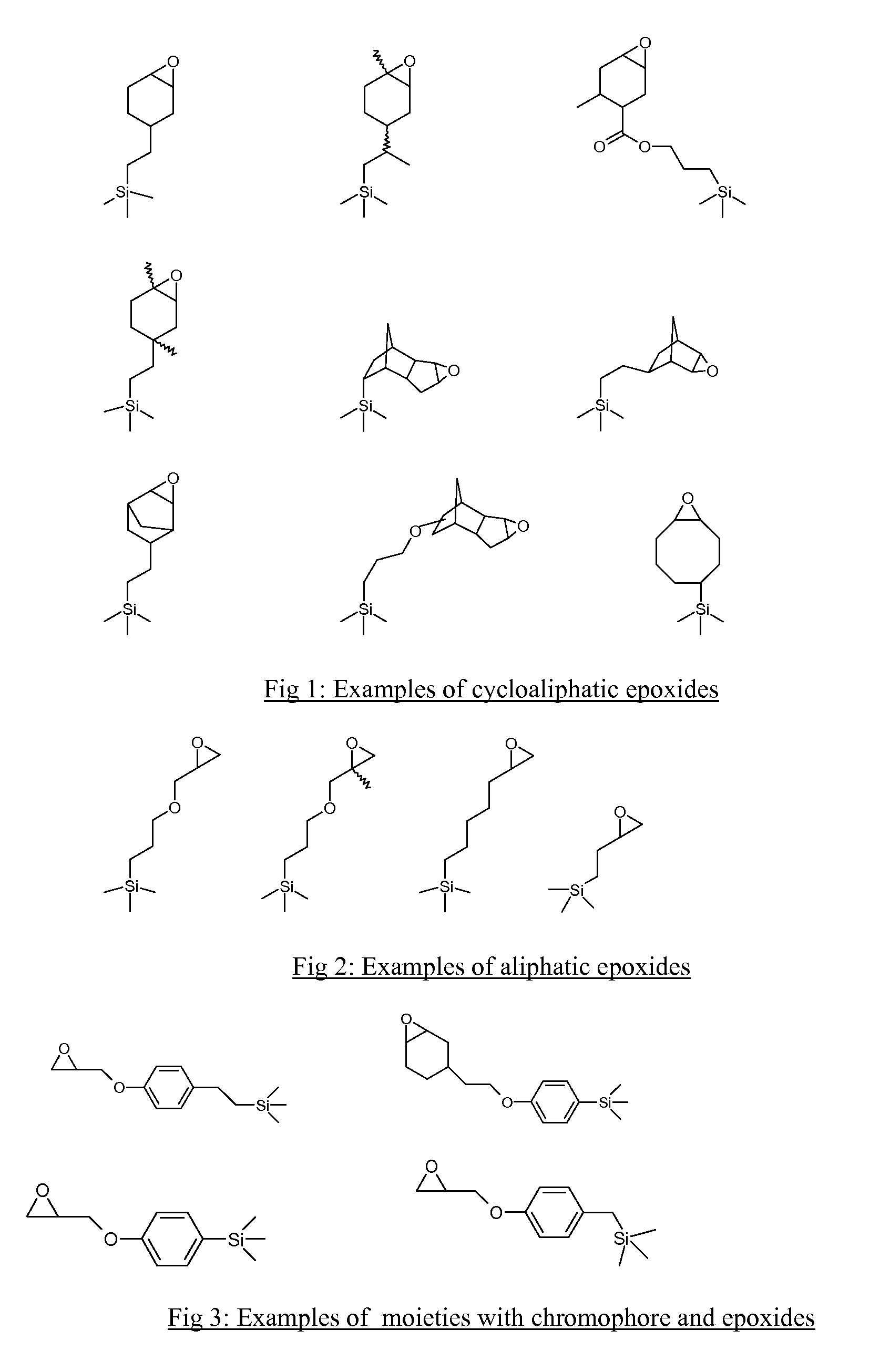Antireflective Coating Compositions Comprising Siloxane Polymer
a technology of anti-reflective coating and polymer, which is applied in the direction of photosensitive materials, instruments, photomechanical equipment, etc., can solve the problems of forming negative images and removing the unexposed areas of coating
- Summary
- Abstract
- Description
- Claims
- Application Information
AI Technical Summary
Problems solved by technology
Method used
Image
Examples
example 1
[0066]A three-neck 500 mL round-bottom flask, equipped with a magnetic stirrer, thermometer and condenser, was charged with 136.1 g of 2-(3,4-epoxycyclohexyl)ethyl-trimethoxysilane (552 mmol), 68.0 g of phenyltrimethoxysilane (343 mmol), and 136.0 g of methyltrimethoxysilane (1.0 mol). To the flask, was added a mixture of 43.0 g of deionized water (DI) water, 18.0 g of acetic acid, and 127 g of isopropanol. The mixture was heated to reflux and kept at that temperature for 3 hours. Then, the mixture was cooled to room temperature. The solvents were removed under reduced pressure to afford 258.7 g of a colorless liquid polymer. The weight average molecular weight was approximately 7,700 g / mol, determined by gel permeation chromatography using polystyrenes as references.
example 2
[0067]A three-neck 250 mL round-bottom flask, equipped with a magnetic stirrer, thermometer and condenser, was charged with 35.00 g of 2-(3,4-epoxycyclohexyl)ethyl-trimethoxysilane (142 mmol), 8.50 g of phenyltrimethoxysilane (43 mmol), and 4.50 g of methyltrimethoxysilane (33 mmol). To the flask, was added a mixture of 5.90 g of DI water, 2.00 g of acetic acid, and 18 g of isopropanol. The mixture was heated to reflux and kept at that temperature for 3 hours. Then, the mixture was cooled to room temperature. The solvents were removed under reduced pressure to afford 41.0 g of a colorless liquid polymer. The weight average molecular weight was approximately 9,570 g / mol, determined by gel permeation chromatography using polystyrenes as references.
example 3
[0068]A three-neck 250 mL round-bottom flask, equipped with a magnetic stirrer, thermometer and condenser, was charged with 18.40 g of 2-(3,4-epoxycyclohexyl)ethyl-trimethoxysilane (75 mmol), 15.00 g of phenyltrimethoxysilane (76 mmol), and 46.40 g of tetraethoxysilane (223 mmol). To the flask, was added a mixture of 21.00 g of DI water, 4.00 g of acetic acid, and 82 g of propylene glycol monomethyl ether acetate. The mixture was heated to reflux and kept at that temperature for 3 hours. Then, the mixture was cooled to room temperature. The volatile components were removed under reduced pressure. The weight average molecular weight was approximately 6,900 g / mol, determined by gel permeation chromatography using polystyrenes as references.
PUM
| Property | Measurement | Unit |
|---|---|---|
| Percent by mass | aaaaa | aaaaa |
| Nanoscale particle size | aaaaa | aaaaa |
| Nanoscale particle size | aaaaa | aaaaa |
Abstract
Description
Claims
Application Information
 Login to View More
Login to View More - R&D
- Intellectual Property
- Life Sciences
- Materials
- Tech Scout
- Unparalleled Data Quality
- Higher Quality Content
- 60% Fewer Hallucinations
Browse by: Latest US Patents, China's latest patents, Technical Efficacy Thesaurus, Application Domain, Technology Topic, Popular Technical Reports.
© 2025 PatSnap. All rights reserved.Legal|Privacy policy|Modern Slavery Act Transparency Statement|Sitemap|About US| Contact US: help@patsnap.com



